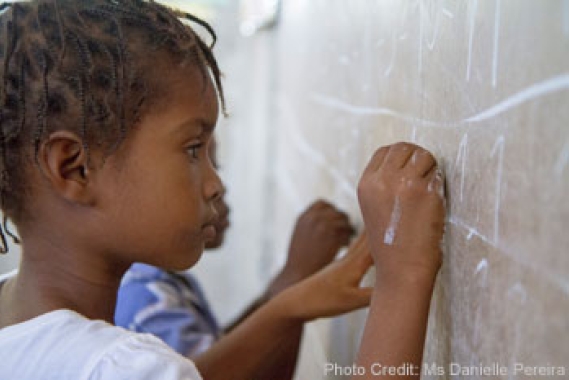Haiti: The Need For Education

In a country where nearly half the population is under the age of 18, education represents a major challenge for Haiti, but also one of the main solutions as well.
In Haiti, 80% of schools are private. There is a huge gap in the quality of education, as only a minority has access to the more sophisticated and well-equipped private system. School fees are required at both private and public institutions. This means education can be out of reach, especially for the 5.5 million Haitians who live on less than a dollar per day. Consequently, illiteracy plays an important role in deepening the social and economic divide; illiterate citizens face even steeper challenges in accessing opportunities that would help them achieve better conditions for themselves and their children.
Since 1978 SOS Children’s Villages has been working in Haiti to support disadvantaged children and families and help improve their life chances. Providing quality schools and education is part of that support.
Charles Myrtil is principal of the SOS School in Santo, a district in the capital city of Port-au-Prince. Mr Myrtil believes the state should provide education, starting with building more schools. He explained that although the government had built schools and promoted free education through a scholarship program in past years, promising and successful programs were not supported by the next government. “One government can start with an initiative but the next one comes along and discontinues it. We start over; we are constantly restarting and that blocks certain initiatives.”
Wadler Raymond, noted that even though the number of children who attend primary school in Haiti has climbed from 50% to 70% in the last decade, access to school varies from region to region. And in this context, rural areas are very far behind.
Another Haiti
Assessments of how well Haiti has recovered from the 2010 earthquake often restrict their analysis to Port-au-Prince, and there is an assumption that measures taken in the capital will work for the rest of the country, as well. Yet the rural areas of Haiti are very different from the capital, and in many ways deprived.
Robenson Claude, the Family Strengthening Program National Coordinator for SOS Children’s Villages Haiti calls this “the other Haiti”.
“There are kids in the other Haiti, the second Haiti, that, to have access to education, must walk 15 to 20 kilometres every day to go to school. There are families that have to walk many kilometres with buckets on their heads ... just to have access to water,” he explained.
According to Mr Raymond, schooling is the answer – the means to escape poverty and deprivation – for children living in remote areas. That is why SOS Children’s Villages provides literacy-training programs, offered in rural community centres.
Laucita Louis lives in the countryside, in a small province near Les Cayes. She works as a laundress to support her family. Due to her parents’ poverty, she never had the opportunity to learn to read and write. When Laucita’s husband died, she found herself alone in the world, with four children to feed, clothe and raise. As hard as she worked, she never could earn enough to get by. Then Laucita discovered the SOS Children’s Villages community centre; finally, two of her children could seize the opportunity she had never had.
“I bring them to school by eight; they come in, they sing, and they are taught how to read and write. They eat twice a day, even when I have nothing to give them,” she said.
Another community member, Gherty Merger, also struggled to provide for her family, despite hard work.
“I have four kids, but two are at the community centre. They are getting an education, the first thing a family needs. Second, they get medical treatment and they also receive food,” she said.
Education to rebuild
During the first twelve months following the earthquake, SOS Children's Villages set up emergency food distribution points and provided food for 40,000 people every day. The organisation also provided emergency medical care for those who needed it and took in unaccompanied and orphaned children, so they would be cared for and protected.
Once the acute stage of the emergency had passed, and the nutritional needs of the community had stabilised, SOS Children’s Villages converted its food distribution points into community centres offering a range of social services for children and families. Currently, children attending the community centres can receive psychological support, education and nutritious food; they can also play and learn about children’s rights.
The former National Director of SOS Children’s Village Haiti, Mario Brusa, explained the bigger vision behind the SOS Children’s Villages community centre educational programs. “We included pre-school activities because we really want to encourage families to get involved, to achieve the dream of having their children get an education.”
“Let’s not forget that one of the millennium development goals is to provide free access to primary school for all,” he added. “And we, with this small drop, are trying to contribute to that.”
Canadian's wishing to support SOS Children's Villages are encouraged to sponsor a child, sponsor a village or to make a direct donation. Your support ensures that SOS Children's Villages can continue to provide a safe and loving home to orphan and abandoned children worldwide.
